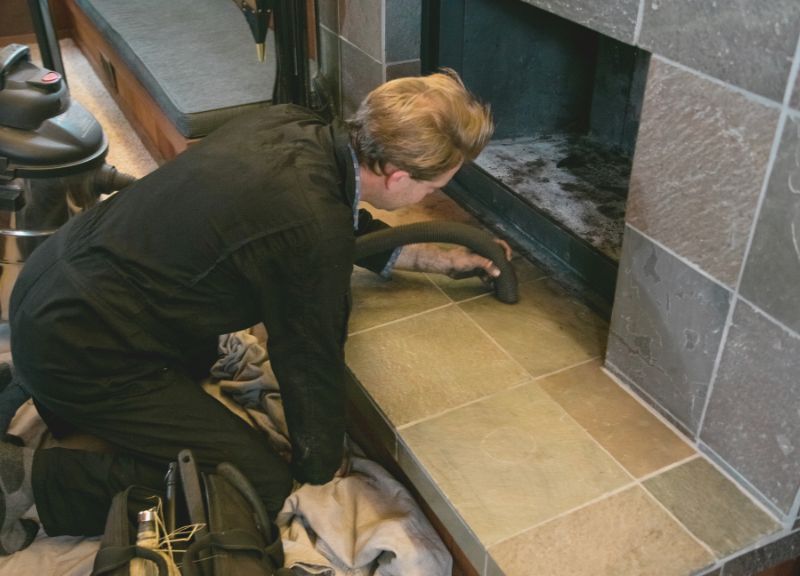Can you wash ceramic fireplace logs if you have a ceramic fireplace in your home? The answer is yes! It’s important to clean your ceramic logs at least once a year to prevent soot and creosote buildup.
Not only can buildup cause discoloration, but it can also be highly combustible. Please keep reading to learn how to wash your ceramic fireplace logs effectively and keep them in good condition.
Key Takeaways
- You can wash ceramic fireplace logs to prevent soot and creosote buildup.
- To clean your logs, turn off the pilot light, remove the logs, and use a stiff brush or vacuum cleaner to remove debris.
- Wipe the logs with a damp cloth and let them dry completely before placing them back in the fireplace.
Table of Contents
Can You Wash Ceramic Fireplace Logs?
You can wash ceramic fireplace logs only with water and a soft brush. You should never use chemicals, detergents, or abrasives to clean ceramic fireplace logs, as they can damage the material and cause it to crack or crumble.
You should also avoid soaking ceramic fireplace logs in water, as they can absorb moisture and become heavy or brittle. Instead, gently rinse them with water and scrub them with a soft brush to remove any loose dirt or debris. You should also let them dry completely before replacing them in the fireplace.
Related: Can you wash cellular shades?
How To Clean Ceramic Fireplace Logs

If you have a gas fireplace with ceramic logs, cleaning them at least once a year is important to keep them looking their best and functioning properly. Here are some steps to follow:
Step 1: Turn off the gas supply and let the fireplace cool down completely.
Step 2: Carefully remove the ceramic logs from the fireplace and place them on a towel or cloth.
Step 3: Use a soft brush, such as a horsehair or ceramic bristle brush, to dust off any loose dirt or debris from the logs. You can also use a vacuum cleaner with a brush attachment to remove dust from the crevices.
Step 4: Dip the brush in water and gently scrub the logs to remove stains or soot. Do not use too much water or pressure, which can damage the logs.
Step 5: Rinse the brush and repeat the process until the logs are clean.
Step 6: Use a towel or cloth to dry the logs thoroughly. Do not leave them wet, which can cause mold or mildew growth.
Step 7: Return the logs to the fireplace according to the manufacturer’s instructions.
Step 8: Turn on the gas supply and enjoy your clean ceramic fireplace logs.
It’s important to note that while cleaning your ceramic logs is a routine maintenance task, there are some precautions you should take to ensure your safety. Always turn off the gas supply and let the fireplace cool down completely before cleaning the logs.

Wear personal protective equipment such as a dust mask and gloves to protect yourself from dust and debris. Additionally, follow the manufacturer’s instructions for log placement and airflow to ensure proper functioning of your fireplace.
Avoid using harsh chemicals or wire brushes when cleaning your ceramic logs, as these can scratch the surface and damage the logs. Instead, stick to a soft brush and water. If you have stubborn stains or soot buildup, use a vinegar solution to help break down the grime.
Related: Can you wash egg crate foam?
How to Clear Soot from the Fireplace
Soot is a common problem that can stain the walls, glass doors, mantel of your fireplace, and ceramic fireplace logs. Adjust your fireplace’s gas pressure and air intake to prevent soot buildup and ensure proper combustion.
Additionally, use high-quality gas that does not contain impurities or additives. You should also avoid placing objects near the flames that can produce smoke or sparks.
If you need to clear soot from your fireplace, follow these steps:
Step 1: Turn off the gas supply and let the fireplace cool down completely.
Step 2: Use a vacuum cleaner to remove loose soot or ash from the fireplace.
Step 3: Spray water on the stained areas and let it sit for a few minutes.
Step 4: Spray vinegar on the water and let it fizz for a few minutes.
Step 5: Use a sponge or cloth to remove the soot and vinegar mixture.
Step 6: Repeat the process until the stains are gone.
Step 7: Dry the fireplace with a towel or cloth.
Step 8: Turn on the gas supply and check for any leaks or problems.
When cleaning your fireplace, it is important to take precautions to avoid scratching the surface or damaging the wiring. Use a soft brush or cloth to clean the surface of your fireplace. Avoid using harsh chemicals or cleaning agents that can damage the surface of your fireplace.
Wear a dust mask and gloves while cleaning your fireplace to protect yourself from dust and debris. You should also cover nearby furniture and flooring with newspaper or a drop cloth to protect them from cleaning chemicals or debris.
Regularly maintaining and cleaning your fireplace can help prevent the buildup of creosote, which can lead to chimney fires and carbon monoxide poisoning. Use a wire brush or hand broom to remove cobwebs or debris from your fireplace.
You can also use a vacuum cleaner with a soft brush attachment to clean the exterior vents of your fireplace.
How to Take Care of Ceramic Fireplace Logs

Ceramic fireplace logs are a great addition to any gas or electric fireplace, providing a realistic look without the hassle of dealing with wood. However, they still require maintenance and care to keep them in good condition. Here are some tips on how to take care of ceramic fireplace logs:
- Clean them regularly to prevent dust, dirt, and soot buildup: Soot and dirt buildup can cause discoloration and may be difficult to remove. You should clean your ceramic logs at least once a year. Follow the previous section’s steps on cleaning ceramic fireplace logs.
- Inspect them for any cracks, chips, or signs of wear and tear. If you notice any damage, you should replace the affected log or contact a professional for repair. Damaged logs can be a safety hazard and affect the performance of your fireplace.
- Store them in a dry and cool place when not in use. You should avoid exposing them to direct sunlight, moisture, or extreme temperatures, as this can cause them to fade, warp, or crack. A dry and cool place will keep them in good condition for longer.
- Rearrange them occasionally to create a different look and prevent uneven burning. Follow the manufacturer’s instructions on how to arrange the logs safely and correctly. Rearranging the logs can also prevent uneven burning and prolong the life of your ceramic fireplace logs.
How Often Do You Need to Replace Ceramic Logs?
Ceramic logs are a popular choice for gas fireplaces because they provide a realistic and rustic look without the hassle of real wood. But how long do they last, and when must you replace them?
Ceramic logs are designed to last many years, but they may need to be replaced eventually due to natural wear and tear or accidental damage.
The replacement frequency depends on several factors, such as the quality and type of the ceramic logs, the frequency and duration of use, the level of maintenance and care, and the condition of the fireplace and gas burner.
Generally, ceramic logs can last up to 10 years or more with proper care and maintenance. [1] However, you should replace them sooner if you notice any of the following signs:
- The logs are cracked, chipped, or broken.
- The logs are discolored, faded, or stained.
- The logs are producing excessive smoke or soot.
- The logs are affecting the performance or efficiency of the fireplace.
Replacing ceramic logs can be tricky, and it’s best to consult with the manufacturer or a professional to ensure proper installation and log placement. Incorrect log placement can affect the airflow and gas valve, leading to safety hazards and damage to the gas line.
In addition to routine cleaning and maintenance, regular inspections can help identify any potential issues with the ceramic logs and prevent them from causing damage to the gas fireplace.
If you need clarification about the condition of your ceramic logs, it’s always better to err on the side of caution and have them inspected or replaced by a professional.
Ceramic logs can provide your gas fireplace with years of enjoyment and warmth. Still, monitoring their condition and replacing them when necessary is important to ensure safe and efficient operation.
Frequently Asked Question
Why do ceramic logs turn black?
Ceramic logs turn black because they collect soot from the gas combustion process. Soot is a black substance that forms when gas or wood burns incompletely in the fireplace. Soot can stain the logs and affect their appearance and performance.
Why do my ceramic logs smell?
Ceramic logs smell because they may have chemical residue or be exposed to impurities or additives in the gas fuel. Chemical residue can come from cleaners, paints, or coatings that are not approved for use on ceramic logs. Impurities or additives in the gas fuel can cause incomplete combustion and produce odors.
How long do Ceramic Fireplace Logs last?
Ceramic logs last up to 10 years or more with proper care and maintenance. However, they may need to be replaced sooner if they are cracked, chipped, broken, discolored, faded, stained, or produced excessive smoke or soot. The lifespan of ceramic logs also depends on the quality, type, frequency, and duration of use.
Can you wash Ceramic Fireplace Logs with vinegar?
You can wash ceramic logs with vinegar only as a last resort. Vinegar is a natural acid that can help remove stubborn soot stains from ceramic logs. However, vinegar can also damage the material and cause it to crack or crumble. Therefore, you should only use vinegar if other methods fail, and you should dilute it with water and rinse it off thoroughly after use.
Can I use baking soda to clean Ceramic Fireplace Logs?
You cannot use baking soda to clean ceramic logs. Baking soda is a base that can react with the acid in the soot and create a harmful residue. Baking soda can also scratch the surface of ceramic logs and make them more prone to soot buildup. Therefore, avoid using baking soda or any other abrasive or harsh cleaner on ceramic logs.







